
Thad's Ancestor Peregine White was born on the Mayflower as is at in Cape Cod Harbor in 1620.
Return to Echo Mtn. Echoes, Fall 1999 Cover
The Early Days of Thaddeus Lowe
THE EARLY DAYS OF TSC LOWE
By Jake Brouwer
 |
Thad's Ancestor Peregine White was born on the Mayflower as is at in Cape Cod Harbor in 1620. |
Quite often after seeking out or being led to the world’s greatest mountain railway, the Scenic Mount Lowe Railway, one finds themselves gathering artifacts, memorabilia and any information they can find out about the place so as to gain a greater insight into its popularity and fame. It is a great passion for collectors across the nation to scour the marketplaces and find tiny treasures to place in glass cases or to adorn a shelf. They are all reminders of the late great past of this wonderful place and in some ways we become part of the essence of Mt. Lowe. Mt Lowe, which without Thaddeus Sobieski Constantine Lowe would not have existed as we have come to know it.
So, for this writer, aside from the silvery spoons and glass treasures that I seek out, there are also the paper treasures or paper trails as I call them. The little scraps and clippings found in newspapers, journals, and histories that help to fill in areas of Thaddeus Lowe’s life, and help us to understand and know him and the railway better.
When we think of the things a person can do in their lifetime and then compare them to the things accomplished by Thaddeus Lowe, we find that Thaddeus has lived life far fuller than most. He was a man that made and lost a number of fortunes in his life, but thanks to his humble beginnings he was a man loved by most who knew him.
Thaddeus came from good people. His mother Alpha Green Lowe was a native of Shelburne, New Hampshire and it was from her that Thad’s strong will was said to come. Thad’s father Clovis Lowe, who graced Thad with his good nature, was born in 1799 and was the son of Levi Lowe and Mary White. Mary Whites father, Peregrine White was born on the Mayflower in November of 1620 as it sat in Cape Cod Harbor. In an early history of the area, it states a pewter platter still exists in the family that was brought to America on the Mayflower.
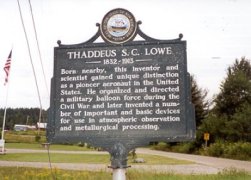 |
A monument placed at the site of Lowe's birthplace in New Hampshire. Courtesy Randolph Historical. |
Levi Lowe is said to have fought in the Revolutionary War however the same two sources say he was sixty four when he died in 1836 making him to young to be in that war. Thad does make the claim of having the blood of Revolutionary ancestors but perhaps that is the showman in him. Born to Levi and Mary was Clovis Lowe in 1799 in the town of Sunkhaze, Maine, and by 1809 the family moved to New Glouster, Maine. During the war of 1812 the fourteen-year-old Clovis Lowe served as a drummer boy in the garrison at Portland. A few years later it became Levi’s custom to drive cattle to Canada. Quite often Clovis would accompany him on the journeys. On one such trip in 1819 they happened to pass through Randolph, New Hampshire, and were so impressed with the surroundings that Levi bought two hundred acres from Silas Bumpus. Levi attended the first meeting of the newly founded town, and became the first town clerk in 1824. On a cleared fifteen acres, Levi and a man from Shelburne named Ingalls, constructed a log cabin that would become the future home of Clovis Lowe.
Clovis became a cobbler and had a shop on the banks of the Androscoggin near Berlin, New Hampshire. Clovis went on to also dabble in politics becoming the selectman to represent at the legislature the district, which consisted of Randolph, Jefferson and Kilkenny. On October 26, 1825 he married Alpha Green daughter of Thomas Green. They produced six children the second of which was Thaddeus.
Life started for Thaddeus Sobieski Constantine Lowe on April 20, 1832 in Coos County, New Hampshire. The family resided in Jefferson, Thaddeus being born in a small yellow-framed house. His name is said to have come from his mother, Alpha Green Lowe, who had earlier read a novel by Jane Potter called Thaddeus of Warsaw. Thaddeus, Sobieski and Constantine being important characters in the book. Born into the drudgery of a farm life, it would take a man having much more than a name larger than life to make a good go of it in those times.
While Growing up he experienced the of the life of a farm boy one hundred and sixty years ago, working in the barn, stocking the woodpile, and toiling in the stony New Hampshire fields. In between chores and studies, Thad learned the simple crafts of the local Indian boys, making baskets, bows and arrows, and moccasins. His meager schooling was limited to three winter months a year when the ground was too hard to work, and an occasional mid summer session. The school had little in the way of books and often his teacher would lend him hers. He would read late into the cold winter nights by the light of pine knots he gathered in the warmer months.
It was a hard life for the Lowe family, and before Thad was 10 years old his mother had died, and he was “bound out” to a neighboring farm. This was simply a custom of the day, and something that had to be done to insure the survival of the family. No one seems to know how long the indenture was to be for, or what terms were to be applied, but it surely wasn’t the right cup of tea for an inquisitive dreamer like Thaddeus Lowe. His new family treated him like a servant, and dismissed many of his questions about life, saying there was too much work to do to fuss with such things. There were no books at the farmhouse, and those borrowed were quickly gone through. Thad continued to dream. When he could, he would lie in the field and gaze at the clouds, watching their movements as they floated across the skies. He wondered about the mysteries of these upper regions. He took note that the higher clouds traveled eastward, even as the lower ones sped to the west. His life, he felt was stagnant and his treatment not what he felt he deserved. Surely there was more to life then working on this farm.
On the Forth of July in 1843 Thad decided to gain his own independence, and he packed a handkerchief with his slim belongings, and headed to Portland, Maine, the largest and closest city at hand, which was one hundred miles away. It took nearly two years to reach his destination working at small jobs for food and shelter. Along the way Thad had these thoughts relayed later in life, “As I walked, I thought over what I was doing, for I had a well developed sense of right and wrong. I did not feel that I was running away from duty or obligation, for I had been too young to know anything about the arrangements which bound me to the farmer or to have any voice in the matter. The blood of Revolutionary ancestors was in my veins, and I had an intuitive belief that freedom was my rightful heritage. I decided that I would find someone who would allow me to study, and would apprentice myself to him on my own terms.”
During this trip to Portland, Thad became aware of an event, which would help to change his life. News had gotten around about the great airship Victoria making a crossing of the Atlantic Ocean from Wales to North Carolina. This was impressive news for these times. The time for trading goods to Europe would be cut drastically, and many people were excited, most of all Thad. He went on to learn more about the Montgolfier Brothers, and other feats of ballooning that fascinated him. It turned out that the story of the Victoria was just that, a fictional work done by Edgar Allen Poe, mistakenly printed by the newspapers as truth. Not at all shattered by this event, Thad thought about the prospect of crossing the Atlantic himself.
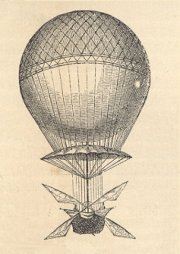 |
Blanchard's Balloon, the first to experience aerial navigation. |
Thad also received the news that balloonist John Wise, was preparing to break the deadlock in Vera Cruz in the 1845 War in Mexico by bombing the San Juan Castle with bombs from the air. The Government however, did not take the plan seriously, and it was quickly discarded. Bonaparte also had considered an air corps as early as 1794. Thad gave all this information serious thought.
Upon reaching Portland Thad worked odd jobs until he secured enough funds to get a berth on a coastal schooner heading to Boston. Once there he met up with his older brother Joseph, and then managed to apprentice himself to Mr. William Otis Nash of Nash, French and Co. at Hingham Center just outside of Boston. The Nash, French and Co were makers of shoes and boots and having a brother and father in the business in the past made the apprenticeship an easy transition. As he watched the laborers cutting the leather for the Congress Gaiters the fifteen year olds mind immediately went to work trying to find an easier way to do the cutting. Thad remembered his days playing with the local Indian boys and making moccasins. The secret to saving time was in lubricating the knife. Thad shared his ideas with his fellow workers and Nash was quite pleased with him.
During this happy time in his life, Thad began experimenting with the idea of lifting a life into the sky. One such experiment involved a cat and a kite. Imagine if you will, what those two could possibly do together and Thaddeus Lowe betters your worst thoughts. He placed the poor black cat into a cage beneath a huge kite built for the occasion and attached a watchman’s lantern beneath it. Then he fastened the apparatus to a hitching post and left it flying there for the night. The next day local newspapers reported seeing strange lights floating about in the evening. The cat of course was terrified and scattered rather quickly upon Thad’s returning him to terra firma. Consider it an early UFO sighting if you like, but Thad decided then and there not to put an animal in harms way again. His thoughts for lifting himself by a kite were shelved for the time being and he started reading every thing he could find on aeronautics.
After working with Nash, French and Company for around two years, Thad went to work with his brother Joseph in the shoe business, but in 1850 Thaddeus had taken seriously ill and returned home to New Hampshire to recover from his illness. His new stepmother Mary Randall Lowe took excellent care of Thad. Mary Randall was from Frankfort Maine and was married to Clovis around the same time Thad was originally bound out. She and Clovis had seven children together. One of the children was Charles Edward Lowe who one night in September 1850, burst into the home with a handbill that said “PROF. REGINALD B. DINCKLEHOFF WORLD REKNOWNED CHEMIST REVEALS WONDERS OF SCIENCE.” A magic and Chemistry lecture was to be held in the town hall. Both Charles and Thad were thoroughly intrigued by the professor’s experiments. One that particularly caught Thad’s interest was the making of hydrogen by placing metal filings into a solution of sulfuric acid. Then placing the hydrogen gas into soap bubbles allowing them to stay aloft for great amounts of time before they popped. At one point Professor Dincklehoff asked for a volunteer from the audience. Thad rushed the stage and after proving his adeptness, and eagerness to the professor, Dincklehoff asked Thad if he might like to return for a few more evenings at a modest salary as his assistant. At the end of the week the show closed and Thad left town with the show as a permanent employee and student.
After two years of traveling on the road, Professor Dincklehoff decided to retire, and Thaddeus stepped in and bought the show. Thaddeus S. C. Lowe was a natural born showman. In his years on the road he learned how to capture the attentions of all those in the audiences, and learned also how to make even the simple minded appreciate the wonders he created on stage. Thad used extra savings to purchase a portable laboratory to take on his lectures adding to the appearance and gaining larger and larger audiences.
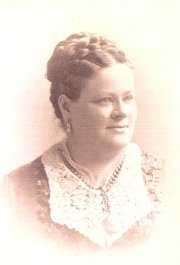 |
Leontine Gachon Lowe in later years, photo courtesy of Joseph Ferm, great-grandson of Thad and Leontine. |
Soon Thaddeus saved enough to settle in New York and attend school learning more in the sciences including medicine. But his mind was now set on devoting his life to aeronautics, and he dove into studying the subject in every free moment between his schooling and lectures. His goal was to build his own aerostat.
Right in the midst of all this swirl of activity one night in a New York audience, the six foot two inch broad shouldered Lowe, spied a wisp of a young woman in the front row. As he presented his lecture in the traditional frock coat, and top hat, his eyes continually strayed to where the young woman sat attentively. She too was watching him.
After the lecture, Thad arranged to meet the young woman, and he was introduced to Leontine Augustine Gachon, a petite young woman seeking a career on the stage. Leontine was born in France, November 30, 1835. Her father was a member of the palace guard for the Citizen King Louis Philippe. When the king was overthrown, the refugee family escaped to America. Thaddeus invited Leontine and her family to dinner, and after a weeklong courtship, the two were in love, and decided to marry. In the same hotel where they had met a Justice of the Peace wed the couple on February 14, 1855.
The Lowe’s took their honeymoon trip leisurely down the mighty Mississippi River on a showboat, wherein Thad performed with a troupe of other performers. In a 20th century newspaper, Thaddeus Lowe Jr. said this; “My father was somewhat of a showman in his youth in addition to being a scientist and a metallurgist. On his wedding tour through the south to pick up a little extra change, he would put on one-night shows in the towns he visited. I believe he had his bride put on marionette shows but I am not sure. Not willing to use his own family name and not caring much for either of his first two names, he concealed his identity behind the pseudonym Professor Carlincourt (or Coulincourt which has been seen also).”
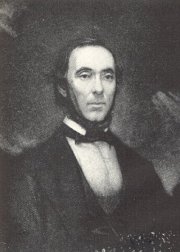 |
John
Wise Balloonist |
Eventually the loving couple moved to New York where Thad resumed his studies of aeronautics, and using his lectures to make ends meet with Leontine’s assistance. They managed to find John Wise’s book, A SYSTEM OF AERONAUTICS, which they devoured, and used to start the patterns and cutting of their own balloon. On a piece of property in New Jersey rented from a Mr. Stevens, Thaddeus worked diligently on constructing his aerostat. During this time in 1856 Leontine was kept at home with the arrival of their first child Louise F. Lowe.
In April of 1857, Thad’s first tethered flight took place on the lot in Hoboken with Leontine looking fearfully on. Thad tossed off the bags of ballast, and rose into the sky. He loved this affair with the heavens, free floating above the ground in the silent air. He also got to see first hand the wind currents he wanted to study further. From that point on, ballooning became an obsession. More and more flights were made, and soon Thad was free flying. Quickly mastering these small trips, Thad began taking passengers aloft for the fee of $1.00 on a tethered flight, and $5.00 on a free flight.
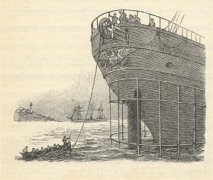 |
In this 1890 engraving we see "THE LANDING OF ONE END OF THE ATLANTIC CABLE," a venture that was to fail a short time later. The failing of the cable led Thad to strive even harder to build a transoceanic balloon. |
1858
saw a visit from Clovis Lowe to see his first granddaughter Louise. Leontine was
pregnant with Ida Alpha Lowe who was born later in that year. Clovis became
wrapped up also with the world of ballooning, and seldom left Thad’s side.
Together they started on a new larger balloon one that Leontine would name
“Enterprise.” This new balloon
was twice the size of the first and made of the finest Indian silk.
At an exhibition in Ogdensburgh, New York Thad, was invited to fly his new aerostat in an upcoming event at Ottawa. This was to be a grand affair celebrating not only Ottawa’s becoming the seat of that Dominion Government, but also the completion of the laying of the Atlantic Cable. It was here that Thad met Samuel Morse and Cyrus Field. That pesky Atlantic Ocean that Thad so longed to conquer was about to be crossed by cable. After ten days, the Atlantic Cable failed and he began again talking of a crossing in a balloon. After the Poe event, the people of the press thought any such idea was pure poppycock, and flat out ridiculed Lowe in the papers.
Thad made many more ascensions experimenting with devises to assist him in his aerial journeys. He discussed with the government, the idea of a weather bureau so others could benefit from climatic information. One of those devises was called the altimeter. He rapidly was becoming known as a qualified balloon manufacturer, and he began receiving orders from across the nation. On a spot of land on the Hoboken farm he built a shed and hired a crew to fill orders.
After the birth of Ida, Lowe moved his family to a town house and hired a nurse, cook and a maid. The money was now coming in quite well and perhaps, Thad foresaw the growth of his family.
On July 4, 1859, not only the countries Independence Day but also Thad’s day of independence from servitude, he sent aloft from the city of Portland, Maine thirty-three brightly colored balloons, one for each state in the Union at the time. It was a grand affair and further demonstrated his theories on eastward air currents as later balloons were spotted sixty miles out to see.
Thaddeus S. C. Lowe was fired up. A transoceanic balloon had to be made and a crossing had to be in his future. His life had led him to this point. The airship must be built and quickly as John Wise seemed to be on the same track as he.
Return to Echo Mtn. Echoes, Fall 1999 Cover
[ Issues | Search | Help | Subscribe | Comment | Websites ]
Send email to Echowebmaster@aaaim.com to report any problems.
Last modified: February 12, 1999
No part of this paper may be
reproduced in any form without written permission from:
Jake Brouwer
All articles and photos were provided by:
Land-Sea Discovery Group
Copyright © 1999